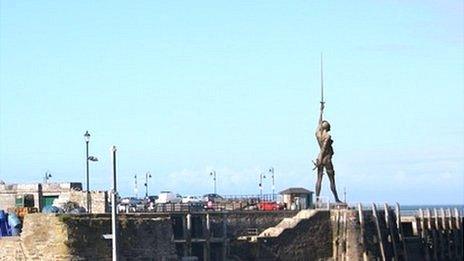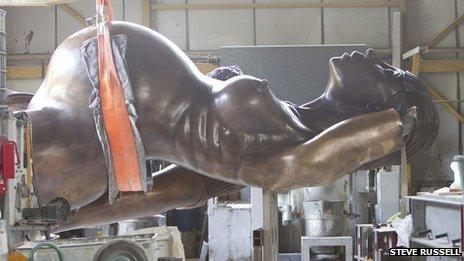Will Damien Hirst's bronze statue Verity regenerate Ilfracombe?
- Published
- comments
Damien Hirst pregnant woman sculpture divides Ilfracombe
The artistic merit of Damien Hirst's giant bronze statue of a pregnant woman has split opinions in Ilfracombe, but it also raises the issue of the role of public art in regenerating a town.
She has been called outrageous, immoral, bizarre, obscene, offensive, disgusting, grotesque, a monstrosity, of no artistic merit and demeaning to women.
Others see her as beautiful and unique, with the power to transform a town's tired image and boost its economy.
This week Damien Hirst's 20.25m (66ft) bronze artwork - known as Verity - is being installed in the Devon seaside town of Ilfracombe.
The artwork is on 20-year loan from controversial artist Hirst, who lives locally and owns a restaurant in the town.
The naked pregnant figure stands looking out from Ilfracombe Harbour, sword held aloft, with part of her anatomy exposed - a baby visible in the womb.
The decision by North Devon Council to grant the statue planning permission follows months of vigorous debate by both the "yes" and "no" camps.
"We need to have a second string to our bow," says Ilfracombe councillor Mike Edmunds, who can see the new arrival from his bedroom window.

Sword aloft: Artist's impression of how Verity will look in Ilfracombe
"We've relied, as a holiday resort, on our natural charm and beauty, but that's not enough in the present day. Hotels are closing, so we've got to do something to boost the economy and we're looking at the arts as a way of encouraging visitors."
Mr Edmunds sees Verity as the "first part of a jigsaw" that would see other works of public art introduced to Ilfracombe.
That might include an arts trail linking Verity to the town's redeveloped Landmark Theatre - notable for its white conical design dubbed "Madonna's Bra".
Mr Edmunds admits there have been strong feelings about the choice of artwork. "Art divides people, and the one thing about Verity is that because it is so controversial it will attract people to the town. I can't see in my own mind why there was such an outcry that it was so offensive."
Chloe Hubbard, editor of of the North Devon Journal, external, says her letters page has been split over the Verity issue.
"We first reported on it eight months ago and we've had letters every single week. I haven't known any subject to have such a long-running interest. Even now Verity's arrived we are still getting protest letters, so people are clearly riled.
"There are people who think it's going to make money for the town and boost tourism, but then there are those who think it doesn't reflect what Ilfracombe's about, and are quite offended by it."
Ms Hubbard thinks Verity may attract a different type of tourist to the seaside resort.
"Ilfracombe is not the most affluent area and anything that can bring money into the area has got to be viewed as a positive thing."
She adds: "Certain parts of the media have massively hammed this story up, saying that the locals are out with their pitchforks and don't want this in the town. That isn't what's happening."
Before North Devon Council passed the planning application this summer, it had received 100 letters of objection, external and 177 letters of support, external of Verity.
Among those objectors was Sue Dale, owner of Ilfracombe's Darnley Hotel, who has now had the chance to see the statue for real.
Her opinion has not been swayed. "I think it's more hideous than I did before, and it isn't suitable for a Victorian seaside town," she says.
"I think it's disappointing that the money and the ideas couldn't have been spent on a proper attraction to encourage people to come to Ilfracombe 52 weeks of the year.
"I've not said we shouldn't have anything there, but I think the statue might be a two-minute wonder. It's not for me and I don't think it's suitable for our harbour."
Mrs Dale is relieved that her hotel does not have a view of he statue. "I feel very sorry for people who may have to look at it every day."
She adds: "I think we'll have to live with it and hope it doesn't become an eyesore with pigeon and seagull droppings and vandalism."
'Great claims'
The aesthetic debate aside, among the arguments in support of Verity was that it would "put Ilfracombe on the map", update the town's image and boost the local economy.
"Great claims have been made about public art and the big criticism is that it hasn't really lived up to those claims," cautions Jonathan Banks, chief executive of public art think tank Ixia, external.
In the case of Antony Gormley's Angel of the North, in Gateshead, he points out that it has been difficult to assess its economic impact separately from other regeneration projects.
"There is a belief that it has changed the perception of the North East [of England] but quantifying that as an economic benefit is a bit more tricky."
The Angel itself was the target of a "stop the statue" campaign in the 1990s.

In pieces: Verity being prepared for her trip to Ilfracombe
"These things tend to grow on people," says Mr Banks. "Over time these sculptures do become symbols of their regions, and replace other symbols or negative images."
The economic downturn and changes to arts funding, he says, have meant a decline in the commissioning of monumental sculptures.
Verity is different in that she is a long-term loan from the artist.
"Public art has moved on quite a long way from these large-scale sculptures. There's a slight tiredness around them. It's become a quite formulaic part of the regeneration agenda," says Mr Banks.
"If the intention was to give Ilfracombe an economic boost then best have an artwork of national or international interest to generate the visitors to see it.
"But then there is there issue of how much the artwork has to do with local people and who the artwork is actually for."
Hirst's work has long stirred up controversy and the artist told the BBC earlier this year that he always tried to ignore the negative reactions.
A Hirst retrospective at Tate Modern in London this summer was the most visited solo show in the gallery's history. Works by Hirst on show included a shark suspended in formaldehyde and an installation comprising a room of live butterflies.
Criticism this week by the RSPCA, external of the butterfly work, and the recent outcry over Verity, indicate that Hirst's ability to polarise opinion is showing no sign of subsiding.
- Published16 October 2012
- Published8 October 2012
- Published17 July 2012
- Published17 September 2012
- Published1 July 2012
- Published2 April 2012